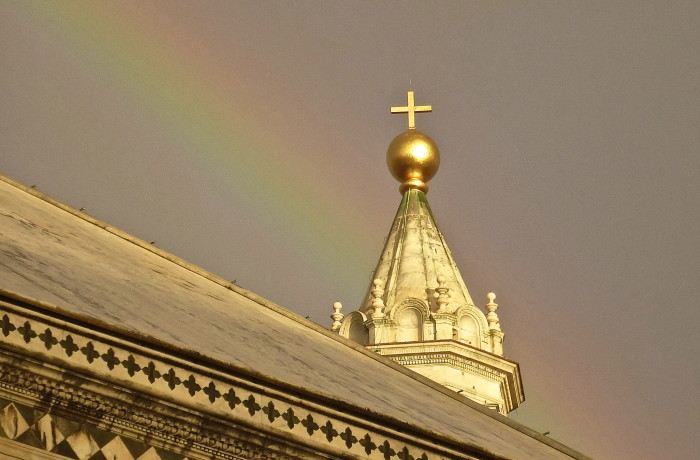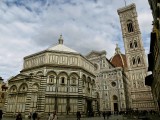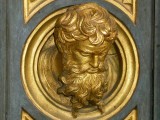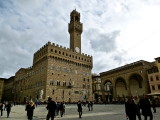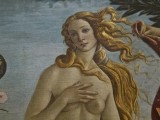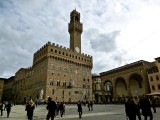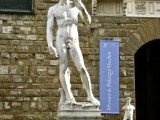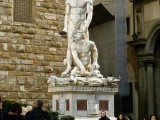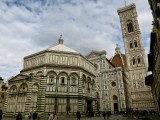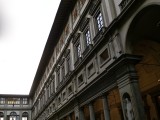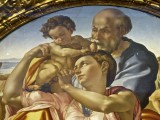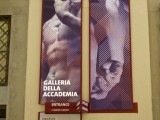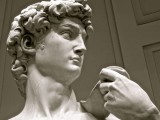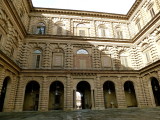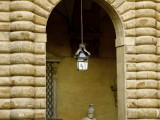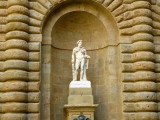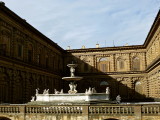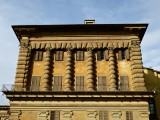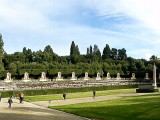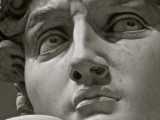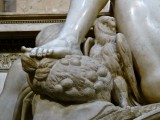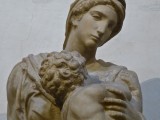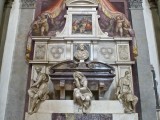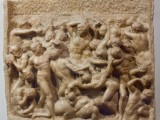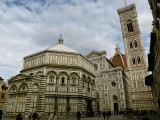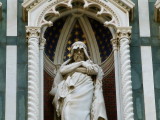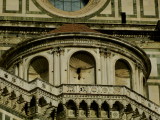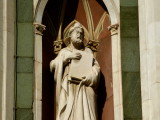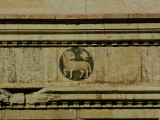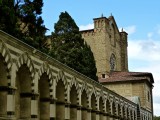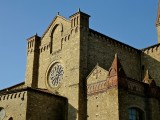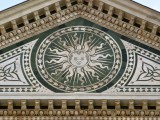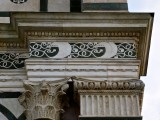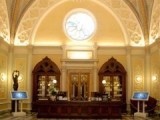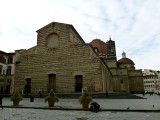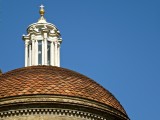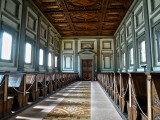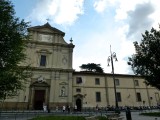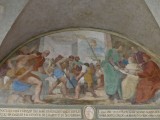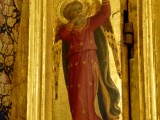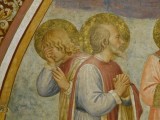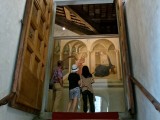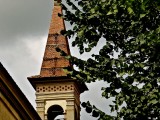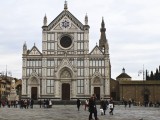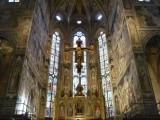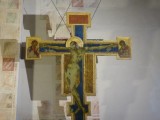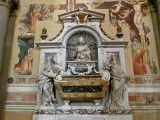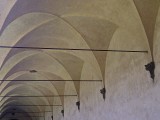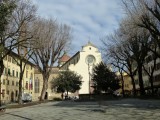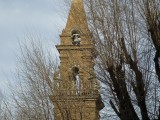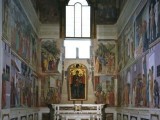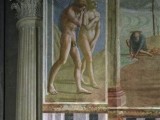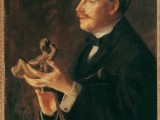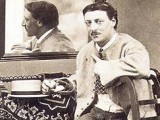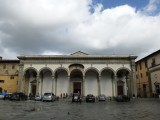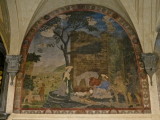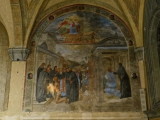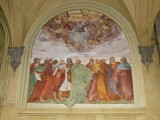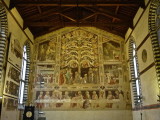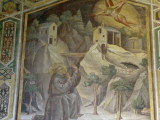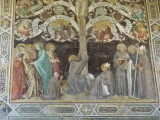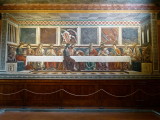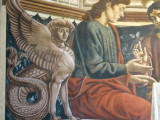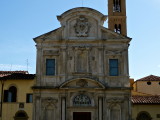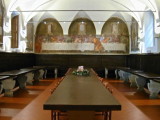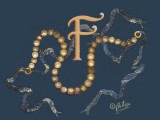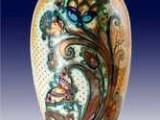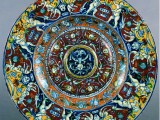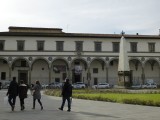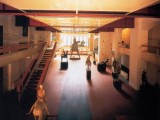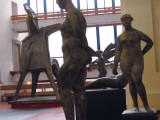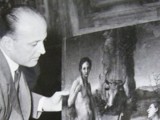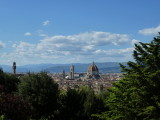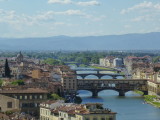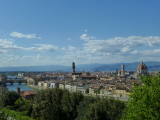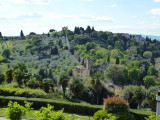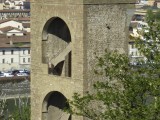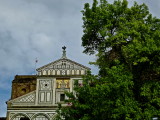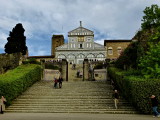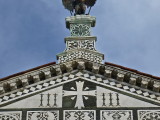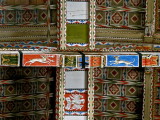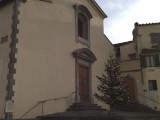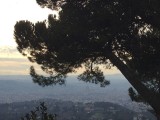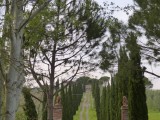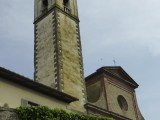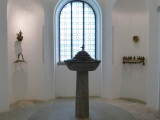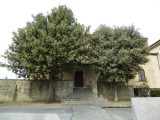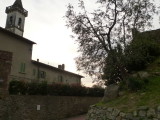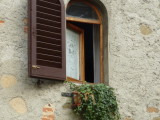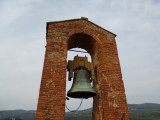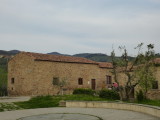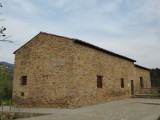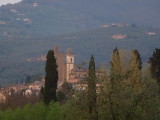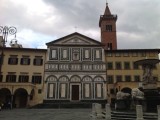The city of Florence and its Major Museums
The historic center and the Uffizi Gallery
The Religious Center: the Cathedral Santa Maria del Fiore, Giotto’s Campanile, and Baptistery; the Political Center: Palazzo Vecchio (on Piazza della Signoria) and the Uffizi Gallery e-mail
The wonders of Piazza del Duomo reveal the genius of the undisputed Great Masters of Florence, the City of the Lilly: the remarkableness of The Gates of Paradise by Lorenzo Ghiberti, the uniqueness of the Clock frescoed by Paolo Uccello inside the Duomo, and the implicit meaning of the elegance and impacting force of the Dome designed by Filippo Brunelleschi. The great achievements of local politicians are celebrated by works they commissioned and that now embellish Piazza della Signoria, a stunning open-air museum from which sculpted heroes have watched the City’s political life evolve. We are taken aback by the humanity of the Majesty by Giotto di Bondone and touched by Filippo Lippi‘s Madonna and Child. We are filled with admiration before the compositive perfection of Piero della Francesca‘s Diptych, the harmony and colors of Sandro Botticelli‘s Venus and Springtime, the scientific rigor of Leonardo da Vinci‘s works, the impact of the composition of Michelangelo Buonarroti‘s Tondo Doni, and the placid serenity expressed by Raffaello Sanzio‘s works.
The historic center and the Academy of Fine Arts Gallery
The Political Center: Palazzo Vecchio (on Piazza della Signoria); the Religious Center: the Cathedral Santa Maria del Fiore, Giotto’s Campanile and Baptistery, and the Academy of Fine Arts Gallery e-mail
Be intrigued by reading the origins of Florence’s power in the architectural styles of the buildings on Piazza della Signoria and in its statues. Be moved by the spirituality with which the small Church of Orsanmichele is imbued. Admire the classical modernity of Piazza della Repubblica. Discover the wonders of Piazza del Duomo, the uniqueness of the bronze panels of The Gates of Paradise by Lorenzo Ghiberti, the peculiarity of the Clock frescoed by Paolo Uccello, and the secrets of the construction of Filippo Brunelleschi‘s majestic Dome. Stand in awe before the first giant statue of Christianity, Michelangelo Buonarroti‘s David, and enjoy learning about the life of this genius, whose talent and pride gained him everlasting fame.
The Uffizi Gallery and the Academy of Fine Arts Gallery
The Uffizi Gallery and the Academy of Fine Arts Gallery e-mail
A journey into art amidst the most exciting masterpieces created by Florence’s masters: Giotto di Bondone, Masaccio, Filippo Lippi, Piero della Francesca, Sandro Botticelli, Leonardo da Vinci, Michelangelo Buonarroti, Raffaello Sanzio, Tiziano Vecellio, and Michelangelo Merisi knows as Caravaggio. Michelangelo Buonarroti‘s sculptures mark the course of his career. The David, Saint Matthew and the Four Prisoners; the last of his mature works and significant examples of his non-finito style, created by skilled hands to celebrate the greatness of Pope Julius II.
The Museums of Palazzo Pitti and the Boboli Gardens
Palazzo Pitti: Palatine Gallery, Modern Arts Gallery, Silverware Museum, Costume Museum, Boboli Gardens, Porcelain Museum (optional: Gardens of Villa Bardini) e-mail
The imposing and elegant Palazzo Pitti, a noble Medicean residence, can be accessed by a vast once-private plaza, the largest in Florence. In the sumptuously frescoed reception halls, notable works by Raphael and Titian are displayed, as well as paintings by Peter Paul Rubens and Antoon Van Dyck. The Modern Arts Gallery houses awe-inspiring masterpieces which comprise works by Macchiaioli artists. The Silverware Museum displays many of the pieces of jewelery of the Medici Family, precious stones and pearls proudly worn by dames and gentlemen during private or official events, such as the fantastic theater performances held inside the Boboli Gardens, a wonderful example of Italian formal-style gardens. These gardens are divided into precise symmetrical sections by pathways, steep stairs and secret artificial grottoes (Grotticina di Madama, Grotta di Annalena and Grotta del Buontalenti).
A day with Michelangelo
Academy of Fine Arts Gallery, Museum of the Medici Chapels, and Cathedral Museum
Bargello Museum, Santa Croce Museum, Museum of Casa Buonarroti e-mail
You can visit the Gallery of the Academy of Fine Arts to admire the David and The Prisoners, mature works of the Genius; the Museum of the Medici Chapels to discover the more intimate aspect of Michelangelo’s soul, expressed by the sculptures Night and Day, Dawn and Dusk, and Madonna and Child, who watches over the mortal remains of Lorenzo the Magnificent; the Museum of the Duomo, which houses the Pietà that Michelangelo sculpted for his tomb. A stop at the Bargello Museum will allow you to wonder at some of the Maestro’s early works; and at the Basilica of Santa Croce you can see where he was buried, after a long career which began when he was a teenager, with his Madonna of the Steps and the Battle of the Centaurs, jealously kept inside Casa Buonarroti.
The Great Churches of Florence
Santa Maria del Fiore Complex: Cathedral of Santa Maria del Fiore, Cript of Santa Reparata, Brunelleschi’s Dome, Giotto’s Campanile, Baptistery of St. John, and Cathedral Museum e-mail
A few hours will be sufficient to relive the greatness of the City of the Lilly between the 5th and 15th century, whose wealth, fame and power produced one the most important religious centers of Christianity. The glossy mosaics inside the Baptistry; the older and more modest ones inside the small Crypt of Saint Reparata; the amazing Clock by Paolo Uccello; Giorgio Vasari’s fresco, which covers the interior of the Dome planned by Filippo Brunelleschi; the vastly assorted reliefs designed by Giotto to decorate the Campanile; the original Doors of Paradise by Lorenzo Ghiberti; and Michelangelo’s Pietà are only a few of the wonderful works that make this religious complex one of the most awe-inspiring in the world.
Dominican Basilica of Santa Maria Novella with annexed Officina Profumo Farmaceutica e-mail
The Dominican Basilica of Santa Maria Novella, constructed between the 13th and 15th century, is a beautiful Italian-Gothic-style church, which protects exemplary works such as the first fresco depiction of Dante’s afterlife world; the Trinity by Tommaso di Ser Giovanni di Mone Cassai, known as Masaccio; the Stories of the Virgin and of Saint John the Baptist to honor the Tornabuoni family, who commissioned the work; and the surreal images of the Universal Flood painted by Paolo Uccello.
San Lorenzo Complex: Basilica of San Lorenzo, Laurentian Library, Museum of the Medici Chapels e-mail
San Lorenzo was the first Cathedral of Florence. It is a treasure trove of priceless masterpieces, such as the bronze pulpits by Donatello, and houses the mortal remains of the members of the Medici family, a tradition which began with the realization of the Old Sacristy, a fine example of Renaissance Humanistic architecture. The Laurentian Library, admirably planned by Michelangelo, is a magical place where no external noise could disrupt the reading of philosophical books that took place there. No sound vibrations will likewise ever disturb the eternal slumber of the Medici inside the New Sacristy.
Dominican Church of San Marco with annexed Museum of San Marco (ex-convent) e-mail
The Convent of Saint Mark enjoyed a new beginning when Cosimo the Elder of the Medici decided to accept Archibishop Antonino Pierozzi’s proposal to atone for his sin of usury by donating money for the refurbishing of the convent. Today the spaces open to the public allow visitors to contemplate the paintings and frescoes by Beato Angelico in an atmosphere still imbued with spirituality, resulting from initiatives and work rich with faith and knowledge.
Franciscan Basilica of Santa Croce with annexed Museum e-mail
The largest basilica of the Franciscan order, where Giotto and his followers painted the first religious scenes in a fully 14th-century Florentine setting; where the mortal remains of Michelangelo Buonarroti, Galileo Galilei, Niccolò Machiavelli, Vittorio Alfieri and Ugo Foscolo are buried; and where Cimabue‘s Painted Crucifix is housed, a survivor of the flood that hit Florence in 1966.
Agostinian Basilica of Santo Spirito and the Basilica of Santa Maria del Carmine with annexed Brancacci Chapel e-mail
The white dove with golden rays on a light-blue background is the symbol of the Oltrarno district, in the heart of which rises the white facade of the Augustinian basilica of Santo Spirito, the last project of the genius Brunelleschi. A very simple exterior holds a complex interior, in which 38 marvelous chapels protect works of intimate value. Enhancing the modest Church of the Carmine is the Brancacci Chapel, with its beautiful frescoes, and the Stories of Saint Peter. With landscapes painted in a realistic manner and figures imbued with psychological profundity, these Stories were a “school of the world”, a starting point for all the investigations on light, perspective, color, and plasticity of the figures carried out by the protagonists of Florence’s artistic renewal, including Michelangelo.
Florence in detail
A City of Great Collectors
Herbert Percy Horne Museum, Stefano Bardini Museum e-mail
Herbert Percy Horne, a London architect with a passion for poetry and artistic historiography, was entrusted with writing a book on Sandro Botticelli. Once in Florence, and as he went deeper into the study of Renaissance art, he began to identify more and more with a person living in those times. Borne from this experience was the idea to create an example of a refined, aristocratic dwelling, the house of a wealthy and cultivated man of the Renaissance. This is the present-day Horne Museum. Stefano Bardini was the most authoritative Italian antiquarian, who contributed to making the Italian Renaissance known world-wide during his years of intense work. His clients included some of the most prestigious collectionists in the world. Statues, paintings, medals, small bronzes, oriental rugs and a small but very important armory are the jewels of this fascinating museum.
Frederick Stibbert Museum e-mail
Frederick Stibbert was an international financier, a regular traveler and a passionate collectionist. His father, Thomas Stibbert, from Norfolk, settled in Florence after marrying a young local lady, Giulia Cafaggi. The collections of the European and Islamic weapons and the Japanese armory here displayed are fantastic. The latter is one of the most conspicuous outside of Japan.
Florence’s Cloisters and Refectories
Cloisters are the heart of monasteries and convents. They are places of silence and peacefulness, ideal settings for meditating. The construction of cloisters began during the Middle Ages and the first to make them an essential element of their places of worship were the Benedictines. It was common in Florence to decorate cloisters with frescoes, which now bear witness to the remarkable skills of the great Florentine painters. In refectories too artists showed off their talents by depicting the theme, the Last Supper, connected with the purpose of this room.
Cloisters: Cloister of the Church of Santissima Annunziata and the Scalzo Cloister e-mail
14th century Refectories: Refectory of Santa Croce (part of the complex of the Basilica of Santa Croce) and the Refectory of Santo Spirito (part of the complex of the Basilica of Santo Spirito) e-mail
15th century Refectories: Refectory of the Church of Sant’Apollonia, Refectory of Fuligno, and Refectory of Ognissanti e-mail
16th century Refectories: Refectory of Santa Maria del Carmine, Calza Refectory, and the Refectory of San Salvi e-mail
Florence and its Manufactories
The Opificio delle Pietre Dure, or Workshop of Semi-precious Stones, perfected the complex and unique art of the commesso fiorentino, creating magnificent mosaics made with semi-precious stones. The two names which represent the production of ceramics in the area of Florence are Chini and Ginori, two factories where precious earthenware was produced and ancient techniques whose history reach back to the Copper Age were employed. Montelupo was known for decorated majolica, the name of which originated from the port of Majorca and which drew inspiration from Hispanic art.
Museum of the Workshop of Semi-precious Stones (Opificio delle Pietre Dure), Florence e-mail
Richard Ginori Museum at Doccia, Sesto Fiorentino e-mail
Chini Manufactory Museum, Borgo San Lorenzo e-mail
Ceramics Museum, Montelupo Fiorentino e-mail
Contemporary Florence
Ancient places as modern venues. The Spedale di San Paolo, in Piazza Santa Maria Novella, is only one of the places where pilgrims could find hospitality from the Middle Ages onward. Today its use is quite contemporary, as it offers visitors the opportunity to discover roughly 300 Twentieth-century works in an interdisciplinary manner. The former, early-Christian church of San Pancrazio is where we can now see Marino Marini‘s artistic evolution. What used to be the home of Rodolfo Siviero still houses his private collection of works dating from antiquity to the 20th century, both donated to the City of Florence.
Museo del Novecento e-mail
Marino Marini Museum e-mail
Rodolfo Siviero Museum e-mail
The Environs
Not only entrancing views over the city for those who look down at Florence from Piazzale Michelangelo, from the hill of San Miniato al Monte or from Fiesole, but also magical and peaceful places imbued with history and art. Not far from Florence is Vinci, where the great Leonardo da Vinci was born, and where we can discover the fruit of his genius and inventiveness in the museum devoted to him. A visit to Empoli and Montelupo is a journey into the artistic and manufacturing traditions of these two cities.
Piazzale Michelangelo and the Basilica of San Miniato e-mail
Fiesole and Settignano e-mail
Leonardo Museum at Vinci e-mail
Empoli and Montelupo and their ceramics e-mail

